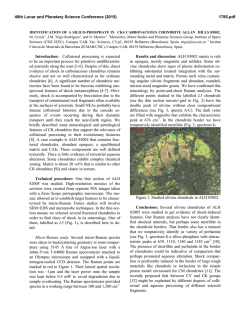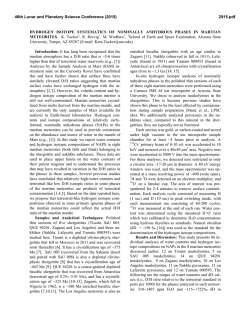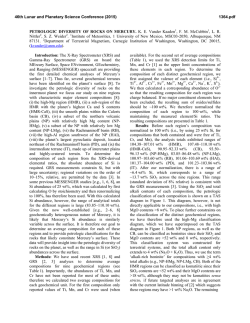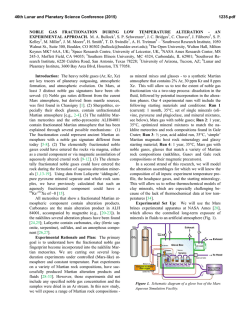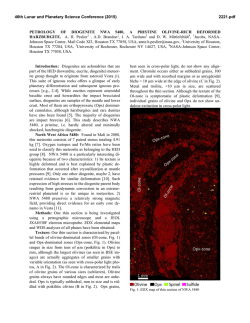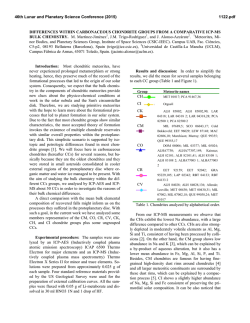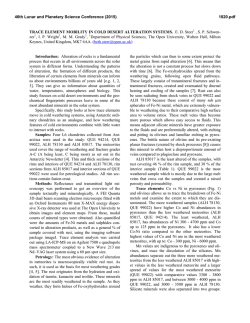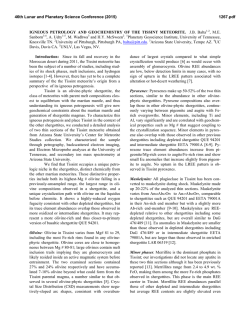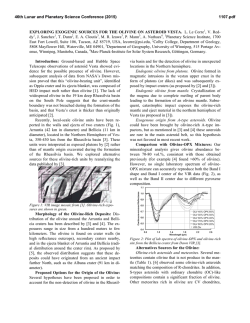
MELT INCLUSION ANALYSIS OF RBT 04262 - USRA
46th Lunar and Planetary Science Conference (2015) 2945.pdf MELT INCLUSION ANALYSIS OF RBT 04262 WITH RELATIONSHIP TO SHERGOTTITES AND MARS SURFACE COMPOSITIONS. S. A. Potter1, A. D. Brandon1, A.H. Peslier2, 1 - University of Houston, Department of Earth and Atmospheric Sciences, 312 Science and Research 1, Houston, TX, 77204, USA. ([email protected]); 2 - Jacobs, NASA-Johnson Space Center, Mail Code XI3, Houston TX 77058, USA Introduction: Martian meteorite RBT 04262 is in the shergottite class. It displays the two lithologies typically found in “lherzolitic shergottites”: one with a poikilitic texture of large pyroxene enclosing olivine and another with non-poikilitic texture [1]. In the case of RBT 04262, the latter strongly ressembles an olivine-phyric shergottite which led the initial classification of this meteorite in that class [2]. RBT 04262 has been studied with regards to its petrology [1,3,4,5,6], geochemistry [7,8,9] and cosmic ray exposure [10,11] and belongs to the enriched oxidized end-member of the shergottites. Studies on RBT 04262 have primarily focused on the bulk rock composition or each of the lithologies independently. To further elucidate RBT 04262’s petrology and use it to better understand Martian geologic history, an in-depth study of its melt inclusions (MI) is being conducted. The MI chosen for this study are found within olivine grains. MI are thought to be trapped melts of the crystallizing magma preserved by the encapsulating olivine and offer snapshots of the composition of the magma as it evolves. Some MI, in the most Mg-rich part of the olivine of olivine-pyric shergottites, may even be representative of the meteorite parent melt [12,13,14,15]. Samples and Methods: In total, 5 MI of varying sizes were analyzed on RBT 04262 with 3 samples residing within the poikilitic lithology and 2 from the non-poikilitic lithology (Fig. 1). Analyses were conducted with a Cameca SX100 electron microprobe (EMP) at NASA-Johnson Space Center (JSC). A backscattered image of each MI was used in a photo-editing software to determine the modal proportion of phases. Combining EMP data and modal %, a bulk composition of each MI was then calculated. The reconstruction of the MI composition, taking into account diffusive exchange with surrounding olivine, was done with the Petrolog3 software suite [16]. Results: The SiO2 content of the MI of RBT increases with the decrease of their Mg#, consistent with the evolution of the parent melt of RBT during crystallization (Fig. 2). This relationship is not as clear in MI data from other shergottites EET 79001 [17], ALH 77005 [18,19] and LAR 06319 [15,20] (Fig. 2). The alkali (Na2O + K2O) versus SiO2 composition of Martian meteorites has been used to try to determine their location of origin on the Martian surface by comparing the sample data to results obtained by Martian rovers [23]. Here, we use this diagram but with the reconstructed MI composition (Fig. 3). It is interesting to note that most other shergottite MI are more clustered than those of RBT 04262 with respect to alkali RBT#04262# EET#79001# ALH#77005# LAR#06319# 75# 70# SiO2%(wt%)% 65# 60# 55# 50# 45# 40# 45# Fig. 1 Plane light photo of the thick section of RBT 04262 studied here. Poikilitic and non-poikilitic lithologies are outlined by the red dashed line. P = Poikilitic and nP = non-Poikilitic. The MI analyzed are marked by blue ellipses. 50# 55# 60# 65# 70# 75# Mg#%of%host%olivine% Fig. 2 SiO2 versus Mg# of host olivine of MI from RBT 04262, EET 79001, ALH 77005 and LAR 06319. P = MI in poikilitic lithology for “lherzolitic” shergottites. 46th Lunar and Planetary Science Conference (2015) Fig. 3 Alkali versus SiO2 contents of MI in olivines from shergottite MI. P = MI in poikilitic lithology for “lherzolitic” shergottites. (Na2O + K2O) versus silica (SiO2) with the exception of two ALH 77005 MI, which have silica and alkali content similar to the MI of RBT 04262. Also note that the data point of RBT 04262 with the highest (Na2O + K2O) is actually data for 2 MI plotting on top of one another. They may have been entrapped simultaneously at either end of the crystallizing olivine grain. The MI of RBT 04262 from the non-poikilitic lithology are, more Si-rich than those of enriched olivine-phyric shergottite LAR 06319 and most of ALH 77005 and extend the bulk composition MI data to both higher alkali and silica contents known for shergottites. Discussion: To further elucidate the possible petrological connections between shergottites and samples analyzed on the Martian surface by rovers and surface maps made from spacecrafts, the compilation from McSween et al. [21] is plotted (Fig. 4). The bulk composition of most shergottites do not overlap with that of rocks from the Martian surface as measured by rovers. Trachyte 8 Basalt trachyandesite Na2O+K2O (wt%) Tephrite 6 Trachyandesite GRS 4 Martian Meteorites Basaltic shergottite Ol-phyric shergottite Lherzolitic shergottite Nakhlite shergottite Pathfinder rock Trachy basalt Basalt Foidite Gusev analysis (Rock RAT, Rock Brush, and Soil) Rhyolite Dacite TES TES Point Density Increasing Basaltic andesite 2 Picrobasalt Bounce rock 0 35 45 55 Andesite SiO2 (wt%) 65 75 Fig. 4 Plot of alkali versus silica with clustering of shergottite MI superimposed over Martian surface data [21]. Gamma-Ray Spectrometer (GRS) and Thermal Emission Spectrometer (TES) are both satellite based instruments. Symbols as in Fig. 2. 2945.pdf However, some of the MI of LAR 06319, EET 79001 MI, ALH 77005, and one from RBT 04262 are similar to rock and soil analyses measured by rovers. Most MI, however, plot away from the rock and soil analyses. The RBT 04262 MI and two ALH 77005 MI, plot between the Gusev, Rock Brush and TES results. Two of the other RBT 04262 MI that plot at high alkali contents, and three of the MI from LAR 06319, both of which are enriched shergottites, and one MI from ALH 77005, which is an intermediate shergottite, plot within and extend beyond the Gamma-Ray Spectrometer (GRS) surface data compositions to higher alkali and silica. The range of SiO2 and alkali content of the MI are in part linked to differentiation processes within each of the meteorites (Fig. 2) but also may have a similar origin in the processes that led to the compositional diversity of GRS surface compositions. At least two distinct differentiation trends, leading away from low alkali and silica shergottite parent magmas, are necessary to explain the range of data exhibited by surface compositions, bulk shergottites, shergottite MI, and Mars surface compositions. MI data strengthens a petrological link between bulk shergottites and the diversity of compositions obtained for rocks at the surface and potentially indicates that all of these were derived from similar parent magmas derived from the Mars mantle. Conclusions: The new MI data from RBT 04262, along with two MI from ALH 77005, plot at the most extreme high alkali and silica compositions measured to present for samples from Mars. These new data imply a link between the surface compositions and shergottite magmas via differentiation. The MELTS program will be used to examine the links. References: [1] Usui T. et al. (2008) MAPS 43, A159. [2] McBride K. (2007) AMN 30, 1. [3] Dalton H. A. et al. (2008) LPSC 39. [4] Mikouchi T. et al. (2008) LPSC 39. [5] Mittlefehldt D. W. & Herrin J. S. (2008) MAPS 43, A100. [6] Usui T. et al. (2012) GCA, 74, 7283-7306. [7] Lapen T. J. et al. (2008) LPSC 39. [8] Park J. et al. (2013) GCA, 121, 546-570. [9] Shih C.-Y. et al. (2009) LPSC 40. [10] Nagao K. & Park J. (2008) MAPS 43, A107. [11] Nishiizumi K. & Caffee M. W. (2010) LPSC 41. [12] Bucholz C. E. et al. (2013) EPSL 374, 145-155. [13] Danyushevsky L. V. et al. (2000) CMP 138, 68-83. [14] Gaetani G. A. & Watson E. B. (2000) EPSL, 183, 27-41. [15] Basu Sarbadhikari A. et al. (2011) GCA 75, 6803-6820. [16] Danyushevsky L. V. & Plechov P. (2011) G3 12, Q07021. [17] Liu et al. (2013) GCA 108 1-20. [18] Ikeda Y. (1998) MAPS 33, 803-812. [19] Calvin C. & Rutherford M. (2008) AM 93, 1886-1898. [20] Peslier A. H. et al. (2010) GCA 74, 4543-4576. [21] McSween H. Y. et al. (2009) Science 324, 736.
© Copyright 2025

